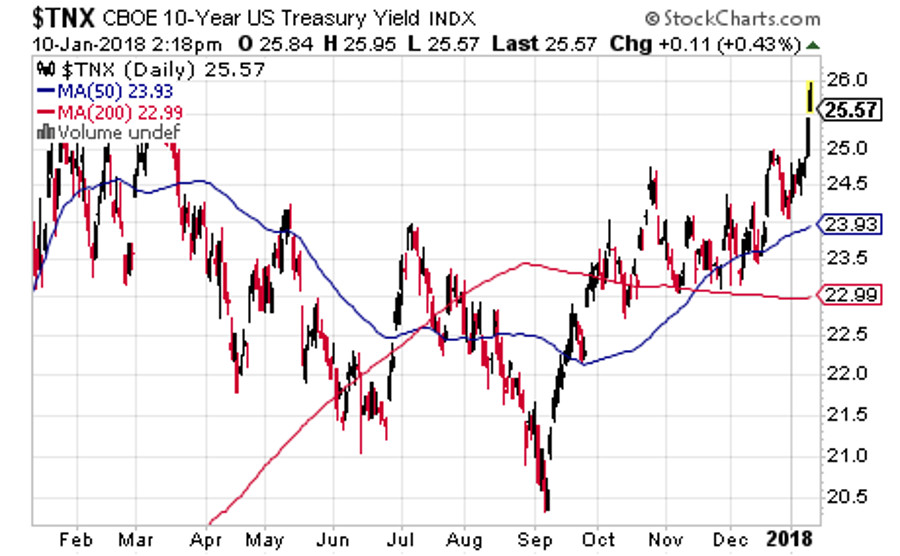With interest rates now at the precipice of a breakout, it’s time to take some preventative action against a swift rise to new cycle highs in yield, explains David Fabian, money manager and editor of Flexible Growth & Income Report.
While this is the third time we have hit the 2.6% range on the 10-Year Treasury Note Yield during the last few years, a break above these levels could lead to uncharted technical territory. The next level of resistance could potentially be in the 3% zone for the 10-Year if this key line in the sand is ultimately violated.
We talked about this key level a lot during the span of 2017, but interest rates never quite had the upside conviction or momentum to mount a meaningful breakout.
With China’s announcement that it will begin reducing the amount of Treasury bond purchases, we could easily begin to see a new paradigm come into play.

China has been the largest consistent foreign buyer of US Treasury debt for decades, alongside the largest domestic purchaser – i.e. the US Federal Reserve.
With the Fed now reducing the size of its balance sheet, and China pivoting its investment pursuits, the backstop that rates have experienced for years may now be removed.
This has the potential to create a glut of supply that is likely to drive rates higher over time. The knock on effect is that you will begin to see all borrowing costs rise, across both the high yield and investment grade spectrum. Moreover, we could begin to see mortgage rates creep higher, along with other consumer debt products.
While these effects could easily be offset by the recent tax cuts for corporations, take note that if the long end of the curve steepens and we see higher rates across the board, it will eat into personal and corporate balance sheets.
On the flip side, the one saving grace could be the continued relative attractiveness of US Treasury yields versus European and emerging market counterparts. With many Euro rates still stapled to the floor through quantitative easing, and the hunt for yield having driven emerging market debt down to very tight levels, US Treasury’s could come out smelling like a rose.
For example, even with 10-Year US Treasury yields at 2.6%, there is still a strong relative attractiveness compared to some of the following countries: Germany 0.54%, UK 1.29%, France 0.81%, Italy 2.03%, Japan 0.08%, South Korea 2.62%, Australia 2.72% just to name a few.
So while rates may be headed higher on a secular basis, we would begin to turn positive on US Treasuries again if spreads widen out versus other nation’s relative financing costs. Furthermore, investment grade corporate and mortgage backed securities could become even more attractive given certain circumstances.
With corporate balance sheets on such stable footing, alongside the aforementioned tax cuts, we wouldn’t be surprised to see corporates “trade through” Treasury bonds. Which means that corporate rates could trade at lower coupon yields in comparison to Treasuries, this happened briefly during the financial crisis.
We are recommending purchase of a 10% allocation in the iShares 0-5 Year Investment Grade Corporate Bond ETF (SLQD).
With the shortened duration and attractive yield of SLQD, we expect this low-cost index fund to weather any additional upside that may follow at the longer end of the curve compared to traditional intermediate-term bond funds. This ETF is currently sporting a 30-day SEC yield of 2.39% with income paid monthly to shareholders.
Furthermore, it’s low-cost structure of just 0.06% annually dovetails with our desire to keep expenses of core holdings within respectable limits. This allocation can help insulate us from the pernicious effects of rising rates helps mitigate certain near-term risks.
Subscribe to David Fabian's Flexible Growth & Income Report here…





















